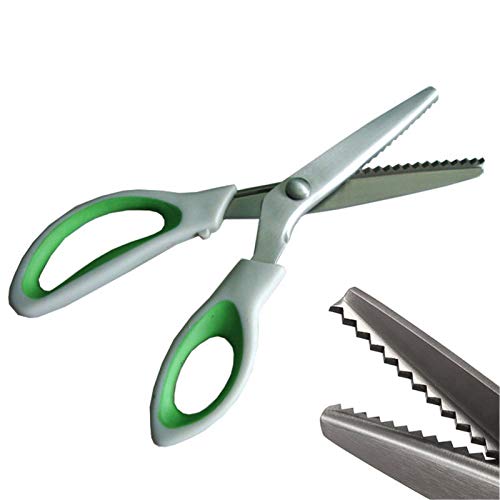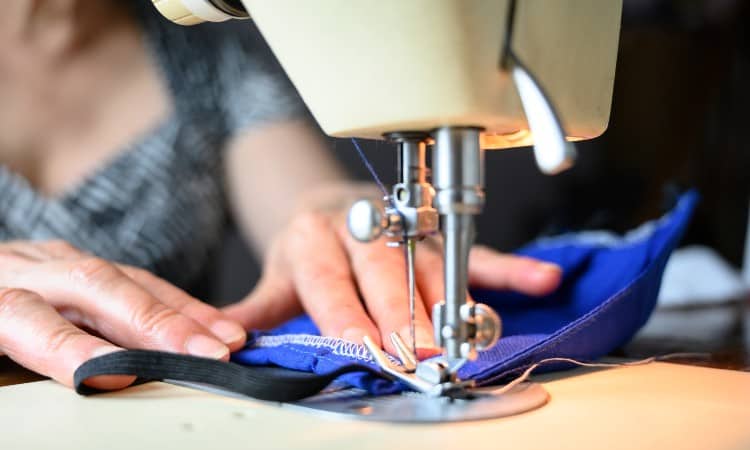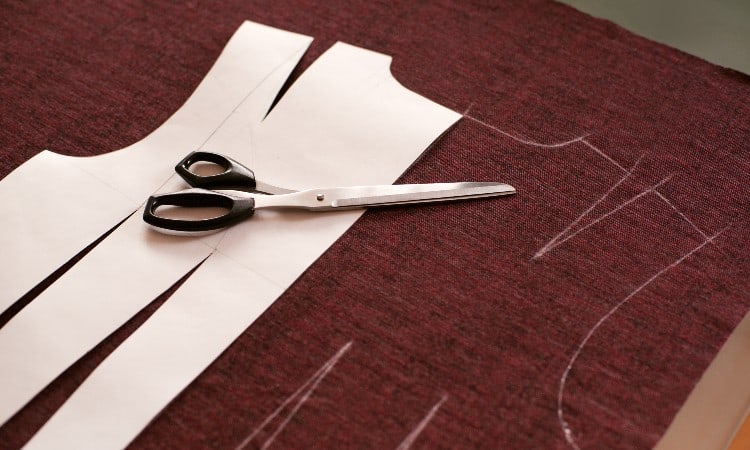There’s nothing more frustrating than when you accidentally snag your favorite blouse and tear it. Suddenly, the fabric starts fraying and if you don’t act fast to stop it, your small problem can become a very big. But how exactly do you stop fabric from unraveling in situations like these?
You can keep fabric from fraying by sealing its outer edges. Store-bought products like fabric glue or nail polish can quickly seal fabrics. Alternatively, you can get rid of frayed edges by sewing a new hem with your trusted sewing machine.
There are many tips and tricks to stop fraying in fabrics, including sewing and no-sew options. Which technique you use will depend on the type of fabric and where the damage is located. Keep reading as we explain exactly how to keep fabric from fraying so that you can fix any fabric you may encounter.

Quick Navigation
- How to Keep Fabric from Fraying Without Sewing
- Using a Sewing Machine to Stop Fraying
- Does Hairspray Prevent Fabric From Fraying?
- How to Cut Fabric Without Fraying
- How to Seal Cotton Fabric Edges
- What Types of Fabrics Fray Easily?
- What Fabrics Do Not Fray?
- How to Stop Fabric Trim From Fraying
- How to Fix Frayed Fabric
- Do Pinking Shears Stop Fabric From Fraying?
- Conclusion
How to Keep Fabric from Fraying Without Sewing
Preventing your fabric from fraying is easy to do. In fact, many household goods and products from your local craft store can protect your fabric – without breaking out your sewing machine!
1. Pinking Shears
 Pinking shears are specialized scissors designed to cut fabric in a way that prevents fraying. Specifically, these shears have a sawtooth or zigzag blade that creates a zigzag edge on any fabric you use them on. It is this unique method of cutting that ultimately stops the fabric from fraying.
Pinking shears are specialized scissors designed to cut fabric in a way that prevents fraying. Specifically, these shears have a sawtooth or zigzag blade that creates a zigzag edge on any fabric you use them on. It is this unique method of cutting that ultimately stops the fabric from fraying.
The zigzag-shaped blades cut the fabric on a bias, shortening the outer threads. While the individual, shorter threads may unravel, they are small enough that they won’t create noticeable fraying on the fabric. The only downside is that the zigzag edge will be visible unless you hem the fabric after cutting.
2. Fabric Glue
 As its name implies, fabric glue is designed to stick to any fabric. Most fabric glues are flexible in ways that regular glue is not. The flexibility stops edges from becoming stiff and lets them move with the fabric as it shifts.
As its name implies, fabric glue is designed to stick to any fabric. Most fabric glues are flexible in ways that regular glue is not. The flexibility stops edges from becoming stiff and lets them move with the fabric as it shifts.
Fabric glue is meant to be permanent and will usually survive being washed in your washing machine. To make sure it doesn’t discolor or stiffen your fabric, test the glue on an inconspicuous spot first. Then, apply a small amount along the frayed edge to seal the threads.
Some craft stores sell specialized glues meant for preventing fraying. These adhesives will be clearly labeled to say they work on fabric edges and will usually have a squeeze nozzle to make application easier.
You’ll want to make sure that you cut the fabric right before you seal it. If you don’t, you’ll probably end up with unwanted threads or debris stuck in the glue.
3. Heat Sealing
Heat sealing is an easy and quick way to prevent fraying on 100% synthetic fabrics. These fabrics contain plastic-like materials that will melt in the heat rather than burn. Because of this, you can use heat to melt the outer edge of the frayed fabric and prevent any additional damage.
Check the fabric to ensure it is made entirely from synthetic fibers like polyester, nylon, or rayon. You will want to avoid natural fibers like cotton, linen, or silk. To heat seal, your synthetics, run a lighter, candle flame, or hot tool along the outer edge.
Be sure to work only on a fireproof surface and move the heat source quickly along the edge. If you go too slowly, you may melt more of the fabric than you mean to. If you’re hesitant to over-burn your fabric, try testing this method on an inconspicuous spot or spare bit of fabric first.
4. Iron-on Hemming Tape
Many craft stores will sell iron-on products to stick fabrics to one another. Iron-on hemming tape will allow you to create a new edge on any fabric you choose, as long as it can withstand the heat of your iron.
To use this product:
- Fold over the frayed edge of the fabric towards the inside of the garment.
- Place the hemming tape along this folded edge, then fold the fabric over again to seal the frayed edges and tape inside the new hem.
- Use your household iron to seal the tape in place.
This product may not work well on lightweight fabrics because it will weigh them down. You’ll also want to avoid see-through fabrics since you’ll be able to see the tape even after you’ve ironed it.
5. Fusible Interface
Most craft stores also sell sheets of fusible interfacing designed to reinforce fabrics. You’ll simply need to iron the sheet onto the inside of the fabric to give it added strength. This can be especially useful for preventing frays in the center of the fabric instead of at the edge.
When you shop for fusible interfacing, pay attention to the thickness of the sheets you choose. You’ll want to purchase a lightweight interface for delicate fabrics and heavyweight interfacing for more robust materials. Like iron-on hemming tape, this interfacing will be visible on see-through fabrics.
6. Nail Polish
If you’re in a hurry, your favorite nail polish may be just the fix you need! You’ll want to choose clear polish or one that matches the fabric’s color. Then, all you have to do is apply a thin layer of polish along the edges of the fabric to seal it.
You’ll want to avoid spilling the nail polish on other areas of the fabric since it may discolor it. Too much nail polish can make the fabric rigid and less flexible. Keep this in mind since it may not work well on lightweight fabrics or clothing that needs to move as you wear it.
Using a Sewing Machine to Stop Fraying

If you have your trusty sewing machine on hand, you can use it to permanently stop your fraying problems. To make your fixes inconspicuous, always use thread that matches the fabric as close as possible.
1. Stitch the Outer Edge
The simplest fix with your sewing machine is to sew along the edge of the fabric with a zigzag stitch. Try to use as small of a zigzag as possible since it will create more stitches and help form a sturdier seam. Any fabric left between the stitch and the edge will continue to fray, so keep the stitches as close to the edge as possible.
This technique works best on woven fabrics, which include cotton or linen. As an additional benefit, the new stitches may even help the edges to lay flatter, thanks to the added weight.
2. Hem the Fabric
With enough extra fabric, you can easily sew a new hem to stop fraying altogether. The best way to do this is with a double-fold hem, which will trap the raw edges inside to keep them from being visible.
To sew this hem, fold the outer edge towards the inside of the fabric. Keep the fold consistent as you work, and aim for it to be ¼ to ½ an inch wide. The raw edge will be visible inside the fabric at this stage.
Fold the fabric over again towards the inside of the fabric. The raw edge should be trapped within the folds when you do this. You can then use your sewing machine to stitch this new hem in place.
A straight stitch will work for most woven fabrics. On the other hand, stretchy fabrics may need a stretch stitch or zigzag stitch to allow the hem to expand with the rest of the fabric.
3. Use a Serger
If you have access to a serger, you could alternatively serge the outer edge to create a clean finish. After all, the primary purpose of a serger is to make neat, professional-looking edges on any project you sew.
If you don’t have a serger handy, see if your regular sewing machine has an overlock edge stitch. This stitch looks similar to a serged edge without requiring extra equipment. The only difference is that your regular machine won’t automatically trim the raw edges as you work.
Does Hairspray Prevent Fabric From Fraying?
Hairspray can work to prevent fraying, but only temporarily. Simply spray a thin and even layer of hair spray across the fabric you want to protect. This is especially useful for preventing runs in pantyhose or nylon stockings.
Hairspray works by stiffening the fabric by making the fibers within stick to one another. It holds the fibers together so they can’t separate and unravel as the fabric moves. The strength of this hold can vary based on how much hairspray you apply and the strength of hairspray you purchase.
Remember that hairspray will wash off in your washing machine, so it’s not a long-term fix. You’ll either need to reapply it regularly or use one of the more permanent options we’ve already discussed when you have a chance.
How to Cut Fabric Without Fraying

Most of the time, whether or not a fabric frays depends on the fibers that make it up and its structure. However, cutting the fabric correctly can also help keep the damage to a minimum.
The best way to prevent fraying is to use pinking shears. Pinking shears have a zigzag blade that creates a finished edge on fabric that generally won’t fray. You can find pinking shears at most craft stores or online.
If you don’t have pinking shears handy, use an extra sharp pair of scissors or a rotary blade. Sharp blades will let you make fewer cuts as you work. Fewer cuts mean fewer opportunities for damage or fraying to happen.
Another easy trick is to line your fabric with fusible interfacing before you make your cuts. The interfacing will keep the edges secure after you cut, stopping the threads from shifting or unraveling.
How to Seal Cotton Fabric Edges
Since cotton is a natural fiber, you won’t be able to heat seal the edges. Heat will cause the fabric to burn rather than melt, which won’t seal the edge as you intend. Instead, you’ll want to use one of the other options discussed above.
Pinking shears will work well to help keep cotton fabrics from fraying. Pinking shears tend to work best on woven fabrics like cotton since they are meant to cut threads on a bias. This stops long strings from unraveling from the weave of the material.
Fabric glue will also work well on cotton fabrics, as will iron-on interfacings and any other permanent sewing options available. Cotton fabrics are easy to hem and these hems can usually be held in place with a simple straight stitch.
What Types of Fabrics Fray Easily?
Most woven fabrics will fray at least a bit when cut, no matter how careful you are. Fabrics with looser weaves usually fray the worst, especially when working with materials like canvas. Fabrics with tighter weaves will generally fray a bit less.
You can tell how tight the weave of a fabric is by looking at it closely. Loose weave fabrics will often have visible space between the fibers, which can be seen if you hold the fabric up to a light source. The fibers in loose weave fabrics may also shift back and forth if you press on them with your fingernail.
Linen, cotton, silk, and even denim are all popular clothing fabrics notorious for fraying. Ribbons and fabric trims are also common culprits. How you prevent fraying in these fabrics depends on what fibers they are made of and what you have on hand.
What Fabrics Do Not Fray?
If woven fabrics are notorious for fraying, non-woven fabrics are the exact opposite. Non-woven fabrics are often made with synthetics that resist fraying even when cut. These fabrics can be torn or pulled apart with tremendous force but won’t usually unravel on their own.
If you’re looking for fabrics that won’t fray, you’ll want a synthetic or a synthetic blend. Try to find polyesters, acrylics, or spandex options. You can also look for knits and faux suede or leather options.
How to Stop Fabric Trim From Fraying
Fabric trims can easily fray and can be tricky to fix if they do. Because trims are usually on the outer edges of the fabric, you probably won’t be able to fold them over to make a hem or stitch the outer edge. Instead, you’ll have to seal the edges.
If the trim is synthetic, try heat sealing it to melt the edges and prevent fraying. This works especially well on synthetic ribbons. Otherwise, you should be able to apply a thin layer of fabric glue to the outer edge to keep it intact.
How to Fix Frayed Fabric
Once a fabric has frayed, it is usually impossible to return it to exactly how it was originally. Most modern textiles are created using custom machinery, which you won’t be able to replicate yourself. However, there are ways to create new, un-frayed edges or disguise damaged portions.
If the fraying is along the outer edge of the fabric, you can create a new edge by hemming it or adding on a new fabric trim. If the fraying isn’t too extensive, you may even be able to seal it to prevent further damage using glue or even heat if the fabric is synthetic.
For damage to the inner parts of the fabric, consider patching any holes with new fabric. You can try to find matching material to make the repairs inconspicuous or choose a contrasting fabric to make a statement. Contrasting colors or patterns will make the patches look deliberate, hiding the fraying in plain sight.
Do Pinking Shears Stop Fabric From Fraying?
Yes! Pinking shears are designed to help stop most fabrics from fraying. They create a clean edge that has a unique zigzag pattern. This zigzag cut shortens the length of the outer threads, keeping any fraying to a minimum.
Pinking shears aren’t a guaranteed fix for all fraying. The shortened threads can still unravel, though the damage is usually minimal. Woven fabrics will still fray more than non-woven fabrics, even when cut with pinking shears.
Conclusion
Fraying fabric can be annoying, but with the tricks we’ve discussed here, you won’t have to worry about it anymore. The next time you have trouble with the fabrics in your daily life, be sure to refer back to this list. You never know when you’ll have to make a quick fix to your favorite outfit!